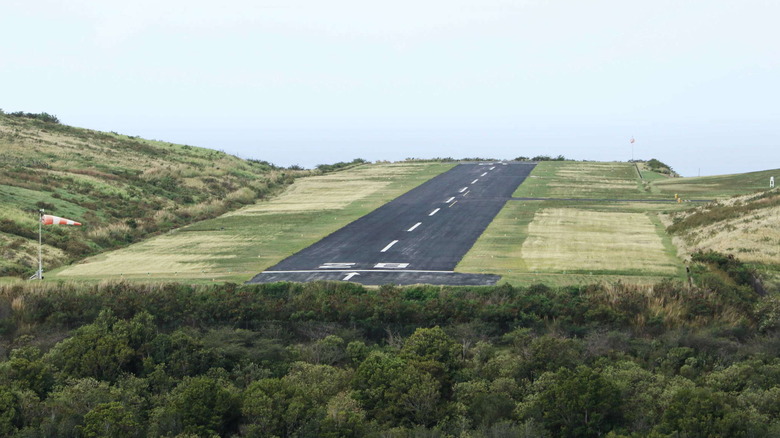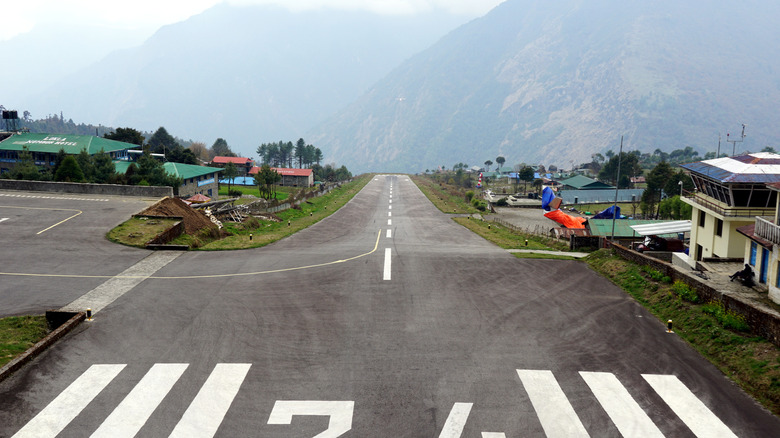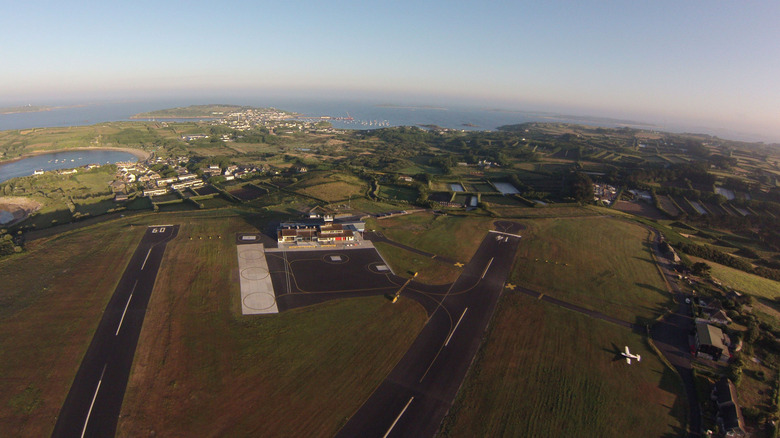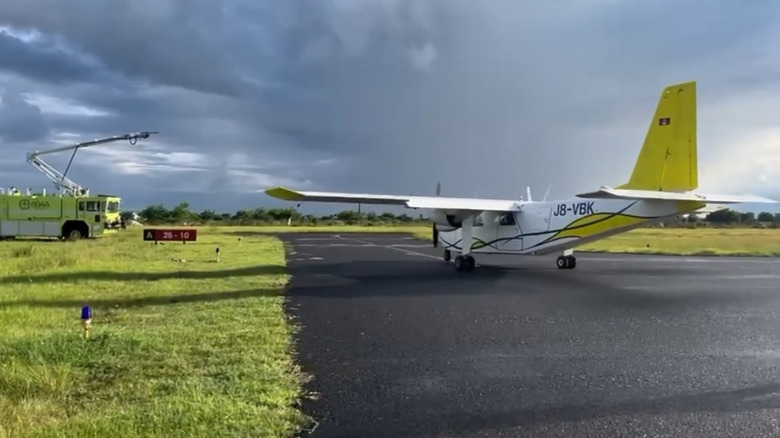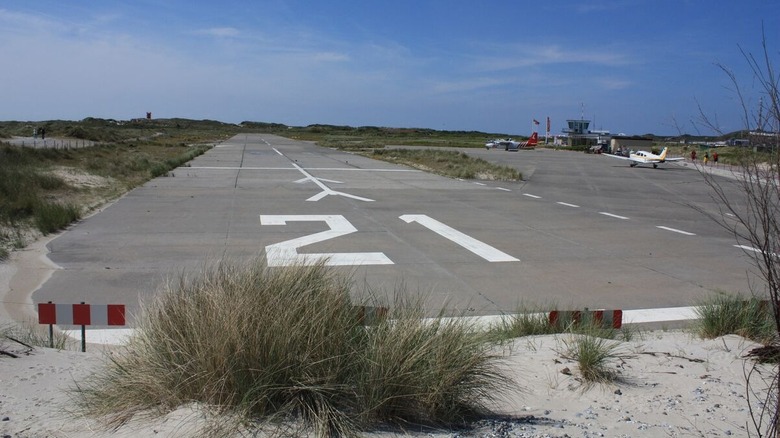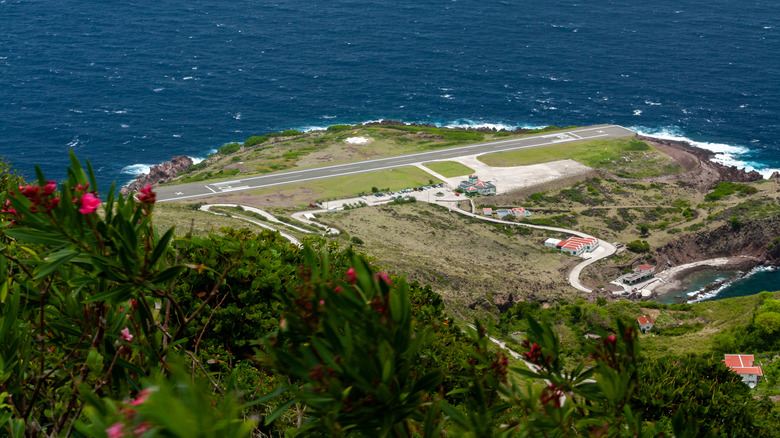10 Of The Shortest Airport Runways In The World
When it comes to airports, runway length isn't just a technical detail, but rather a non-negotiable part of flight safety. Airports that have longer runways give aircraft the space they need to build up speed for takeoff or slow down after landing, and a runway's ideal length is often determined by the type of aircraft using it, the airport's altitude, surrounding geography, and typical weather conditions. In the United States, most major commercial airport runways range from 8,000 to 13,000 feet. Bigger hubs stretch beyond that, giving wide-body passenger jets plenty of room to maneuver during high-altitude or long-haul operations, and there are even several big private jet airports that give them a run for their money.
However, there are a handful of commercial airports around the world operating with staggeringly short runways — some of them less than 1,640 feet (500 meters) long. These aren't isolated backcountry fields, but actually functioning commercial airports, serving scheduled passenger flights in places where terrain, weather, or sheer remoteness leave little choice but to build small. They rely on aircraft with the Short Takeoff and Landing (STOL) designation and specially trained pilots who know how to operate within incredibly thin margins.
This list focuses on airports that currently offer or have recently supported scheduled commercial service, so no private jet airports, ranch airstrips, backwoods gravel runways, or rural fields. Each of these runways is an outlier in aviation design, and a testament to what's possible when space is limited but there's still the need to fly and the "need for speed" as Maverick and Goose would say in "Top Gun."
Gustaf III Airport – Saint Barthélemy, Caribbean
Nestled in the village of St. Jean on the Caribbean island of Saint Barthélemy, Gustaf III Airport, also known as Rémy de Haenen Airport, boasts a commercial runway measuring just 2,119 feet (646 meters) in length. It's an extremely compact runway, with a steep hill on one end and the waters of St. Jean Beach on the other, creating a dramatic and challenging environment for pilots.
The airport's particularly unique topography also necessitates a steep descent over the hilltop traffic circle before touchdown, with departing aircraft ascending directly over locals or tourists visiting the beach below. These are some demanding conditions, so only specially certified pilots are authorized to operate here, requiring additional training and a minimum number of supervised landings to ensure safety.
Given the runway's limitations, Gustaf III Airport accommodates only small, STOL aircraft. Commonly seen models include the Pilatus PC-12, Cessna 208B Grand Caravan, de Havilland DHC-6 Twin Otter, and Britten-Norman BN-2 Islander. Larger commercial jets are unable to land here, making the airport a hub for regional flights and private charters. Despite its challenges, Gustaf III Airport maintains a commendable safety record, thanks to stringent regulations and the expertise of its pilots. Its thrilling approach and picturesque setting have made it a favorite among aviation enthusiasts and travelers seeking an unforgettable arrival experience in the Caribbean.
John A. Osborne Airport – Montserrat, Caribbean
Tucked into the northern end of the island of Montserrat in the British West Indies, John A. Osborne Airport is the only aviation gateway to a volcanic Caribbean paradise. The airport's single runway stretches just 1,814 feet (553 meters), making it one of the shortest commercial airstrips in the world. It opened back in 2005, replacing the former W.H. Bramble Airport, which was destroyed by pyroclastic flows in the 1997 eruption of the Soufrière Hills volcano. The airport is a specialized hub for inter-island travel and essential services, but it's equipped to support both domestic and some international arrivals. For travelers, the approach over the island's lush hills offers a scenic and memorable entry to one of the Caribbean's most resilient destinations.
Because of its short runway and mountainous surroundings, only small STOL aircraft are cleared to operate in and out of the airport. Common aircraft include the Britten-Norman BN-2 Islander and similar lightweight turboprops, typically operated by regional carriers like Fly Montserrat and Air Antilles. Larger commercial jets, especially those like the pilot-beloved Boeing 757, are not permitted due to safety and space constraints, and even some aircraft it was originally designed for, like the Twin Otter, are still under debate. Pilots must undergo specialized training to handle the unique demands of operating at MNI, including short field landing techniques and adapting to sudden weather shifts, which are fairly common in this part of the Caribbean, something they likely wish passengers knew about their challenging job sometimes.
Courchevel Altiport – Courchevel, France
Perched high in the French Alps at an elevation of 6,588 feet, Courchevel Altiport is one of the most dramatic and technically challenging airports in the world. Its runway measures only 1,762 feet (537 meters) in length and is carved into a mountainside, featuring a steep 18.7% gradient. That's an unbelievable rarity in global aviation. The runway is also unidirectional, meaning aircraft must land uphill and take off downhill, with no room for error or go-arounds. Serving the upscale ski resort of Courchevel, the altiport was built strictly for fast, efficient access to the slopes for high-end travelers.
Due to its elevation, short runway, and sloped terrain, Courchevel Altiport is strictly limited to small STOL aircraft and helicopters. Popular aircraft include the Pilatus PC-12, Cessna 208 Caravan, and helicopters like the Airbus H130. Fixed-wing operations require a specialized mountain pilot certification under French civil aviation regulations, with strict criteria for both training and experience. Only a select group of operators and aviators is authorized to land. Talk about exclusivity.
The altiport also does not support night operations or instrument approaches, making visual landing conditions essential. Weather can shift quickly in the Alps, meaning there's another layer of complexity to an already high-risk environment for pilots, but they're trained to handle nature's challenges. For those who make the trip, the reward is stunning: a rapid descent from sky to slope, with a breathtaking aerial view of snow-covered peaks. Courchevel's runway may be short, but its reputation looms large in the world of mountain aviation.
Tenzing-Hillary Airport – Lukla, Nepal
Often dubbed the most dangerous airport in the world, Tenzing-Hillary Airport is in Lukla, Nepal, and it's an adrenaline-filled gateway to the Himalayas. At just 1,729 feet (527 meters) long, its sloped runway sits on a narrow mountain shelf at an altitude of 9,334 feet, surrounded by steep cliffs and towering peaks. Built in 1964 and named after Sir Edmund Hillary and Tenzing Norgay, the first climbers to summit Mount Everest, the airport plays a vital role for trekkers and climbers heading to the Everest Base Camp, as well as for local transportation and emergency services.
The extreme geography surrounding Lukla leaves little room for error. The runway starts at the edge of a cliff and ends at a solid rock wall, offering zero chance for go-arounds or missed approaches. Pilots must land uphill and take off downhill, and the airstrip's steep 12% gradient helps slow landing aircraft while aiding in takeoff acceleration. Only experienced pilots certified for STOL operations and with specific mountain flying credentials are permitted to operate here. Many undergo additional simulator and other training before being approved to fly into Lukla.
Aircraft servicing the airport are typically small turboprops like the de Havilland Canada DHC-6 Twin Otter and Dornier 228, chosen for their reliability and maneuverability at high altitudes. Weather conditions in Lukla can change rapidly, often delaying flights for hours or days. Despite the risks, the airport remains essential to the region, offering access to one of the most iconic adventure destinations on Earth.
St. Mary's Airport – Isles of Scilly, U.K.
Located on St. Mary's, the largest of the Isles of Scilly off the southwest coast of Cornwall, St. Mary's Airport serves as the primary aviation lifeline between the remote archipelago and mainland England. Its main runway measures just 1,722 feet (525 meters), placing it among the absolute shortest in the world. Opened in 1937, this airstrip is vital for transporting residents, tourists, and goods to and from the island, where ferry access can be slow or weather-dependent.
Given the limited runway length and geographic constraints, only small aircraft certified for STOL operations can serve St. Mary's. Currently, the airport is serviced by regional carrier Skybus, which operates de Havilland DHC-6 Twin Otters and Britten-Norman Islanders — both known for their short-field performance and rugged reliability. These aircraft connect St. Mary's to destinations like Land's End, Newquay, and Exeter on the mainland.
Due to shifting coastal winds, changing weather patterns, and the tight approach paths over water and rocky cliffs, pilots must be specially trained for operating in and out of St. Mary's. Though not as visually extreme as Lukla or Courchevel, the airport demands precise flying and familiarity with its environment. St. Mary's Airport might not be the flashiest destination on this list, but it's a perfect example of how short-runway airports can serve as indispensable links for isolated communities without sacrificing safety or functionality.
Barbuda Codrington Airport – Barbuda, Caribbean
Barbuda Codrington Airport is a modest, but essential aviation gateway to Barbuda, the lesser-known sibling to Antigua in the twin-island nation of Antigua and Barbuda. Its runway maxes out at just 1,640 feet (500 meters), making it one of the shortest in the Caribbean. Located a few miles from the town of Codrington, the airstrip is a vital conduit for regional connectivity, supporting domestic flights, air taxis, medical evacuations, and emergency supply deliveries — especially crucial during hurricane season.
The airport has been a symbol of recovery and resilience after Hurricane Irma devastated much of Barbuda in 2017, including the original infrastructure. Since then, Barbuda Codrington Airport has undergone extensive rebuilding and upgrades to support consistent air service for residents and visitors alike. Despite improvements, the runway remained limited in size due to geographic constraints, restricting operations to small aircraft with STOL capabilities, and it was recently replaced and expanded in October 2024 to become Barbuda International Airport.
Flights to and from Barbuda Codrington Airport had been operated by carriers like SVG Air and Caribbean Helicopters using Britten-Norman Islanders and Cessna 402s. These types of aircraft are well-suited for short runways and inter-island hops. Pilots flying into Codrington required experience with short-field landing procedures, as the approach can be influenced by trade winds and occasional crosswinds from the Atlantic. Though modest in scale, Barbuda Codrington Airport played a major role in the daily life and tourism economy of the island. It exemplified how small-scale infrastructure can still deliver big logistical value in the Caribbean.
Inishmore Aerodrome – Aran Islands, Ireland
Inishmore Aerodrome is set against the rugged backdrop of Ireland's Atlantic coastline and air links to the largest of the Aran Islands, Inis Mór. Its single runway measures just 1,608 feet (490 meters), making it one of the shortest commercial runways in Europe. Situated near the village of Kilronan, the aerodrome connects the culturally rich and remote community with the mainland, particularly Galway, through short-haul flights that are often the fastest and most reliable means of access, especially during rough sea conditions.
Inishmore Aerodrome is operated by Aer Arann Islands, which flies the Britten-Norman BN-2 Islander, a twin-engine aircraft specifically designed for STOL operations on rural and undeveloped airstrips. These aircraft are ideally suited to the aerodrome's limited space and frequent challenging weather, with crosswinds and fog rolling in from the Atlantic being regular variables in flight planning.
Pilots flying into Inishmore require certification for STOL operations and familiarity with the island's microclimates. While the approach isn't as visually extreme as a mountain or cliffside runway, the low altitude, compact layout, and coastal exposure demand precision and experience.
Though minimalist in design, Inishmore Aerodrome is critical to island life. It ensures residents have access to healthcare, supplies, and transportation, while also supporting the island's growing tourism industry. Passengers headed to explore prehistoric stone forts or simply chasing the serene charm of the Aran Islands will find the tiny runway as their airborne entry to a timeless destination.
Heligoland Airport – Heligoland, Germany
Hovering just above sea level on Germany's only offshore island, Heligoland Airport holds the distinction of operating one of the shortest commercial runways in Europe. The primary landing strip measures only 1,575 feet (480 meters) and sits on Düne, a small neighboring islet separated from Heligoland by a narrow channel. With the North Sea stretching in every direction, the airport feels more like an aircraft carrier than a typical terminal, and it demands similar precision from pilots.
Because of its short length and oceanfront exposure, Heligoland Airport only accommodates small STOL-capable aircraft. The Britten-Norman Islander is the primary aircraft used by regional operator OFD (Ostfriesischer-Flug-Dienst), which runs scheduled flights to and from mainland cities like Nordholz and Cuxhaven. The Islander's short-field performance and rugged build make it ideal for the tight space and frequently gusty North Sea winds.
Landings at Heligoland require specialized short-field training, with pilots needing to account for shifting crosswinds, low visibility, and the ever-present possibility of seabirds crossing the runway. Despite the limitations, the airport is fully functional year-round and offers vital access for residents, scientists, and tourists heading to the archipelago's marine reserves or iconic red cliffs.
While Heligoland Airport may be small, its strategic importance looms large. It connects one of Germany's most isolated communities with the mainland, providing a critical link for travel, supplies, and emergency services, all from a runway barely longer than a football field.
Juancho E. Yrausquin Airport – Saba, Caribbean Netherlands
Tucked onto the Dutch Caribbean island of Saba, Juancho E. Yrausquin Airport is officially home to the second-shortest commercial runway in the world, stretching just 1,312 feet (400 meters) end to end. With steep cliffs on one side and the ocean on the other three, the runway is carved out of a strip of land barely wide enough to hold it. Similar to several others on our list, there's no room for error, no space for a go-around, and absolutely no operations after dark. It's aviation's equivalent of threading a needle — except you're doing it with wind and crosscurrents in paradise.
Because of the extreme terrain and length restrictions, only specially certified pilots are permitted to land here, and only small STOL-capable aircraft can operate safely. The De Havilland DHC-6 Twin Otter is the workhorse of the route, typically operated by Winair, which runs daily flights to and from Sint Maarten. Helicopters also occasionally serve the airport, but fixed-wing commercial jets are entirely out of the question.
The approach to Saba requires a sharp descent over mountainous terrain, followed by a tight alignment with the airstrip that ends dramatically at a cliff's edge. Departures, meanwhile, launch aircraft directly over the ocean with no margin for hesitation. Despite the daring design, the airport boasts an impressive safety record, thanks to strict operational rules and experienced crews.
For thrill-seeking travelers and aviation fans, landing at Saba is still a once-in-a-lifetime moment and a bold testament to how far humans will go to stay connected, even in the most remote corners of the world.
Out Skerries Airport – Shetland Islands, Scotland
Remote, windswept, and undeniably rugged, Out Skerries Airport holds the distinction of having the shortest commercial runway in the world at just 1,195 feet (364 meters) long. Located on the easternmost inhabited islands of the Shetland archipelago, this tiny airstrip serves the community of Out Skerries, which has long relied on it for essential goods and services, and access to mainland Scotland. The runway spans the width of the island's narrow neck and is surrounded on all sides by the frigid waters of the North Sea, adding both to its beauty and its challenges.
Out Skerries Airport is operated by the Shetland Islands Council and has historically supported flights by Directflight (formerly Loganair), which used Britten-Norman Islanders, aircraft specifically built for STOL operations and capable of handling the high winds and abrupt landing zones common across the Scottish Isles. Flights connected the Out Skerries with other parts of Shetland, such as Lerwick and Tingwall, drastically reducing travel time compared to infrequent ferry services.
Due to the airport's ultra-short runway and often unpredictable weather, only a small number of pilots are certified to land here, and operations have been sporadic or suspended in recent years due to funding and logistical constraints. Still, when active, Out Skerries Airport served as a critical lifeline for islanders, offering medical evacuation capabilities and improved mobility in a place where sea travel is not always feasible.
It may be short on tarmac, but Out Skerries Airport is long on resilience. It's a nice reflection of the spirit of the people it serves.


